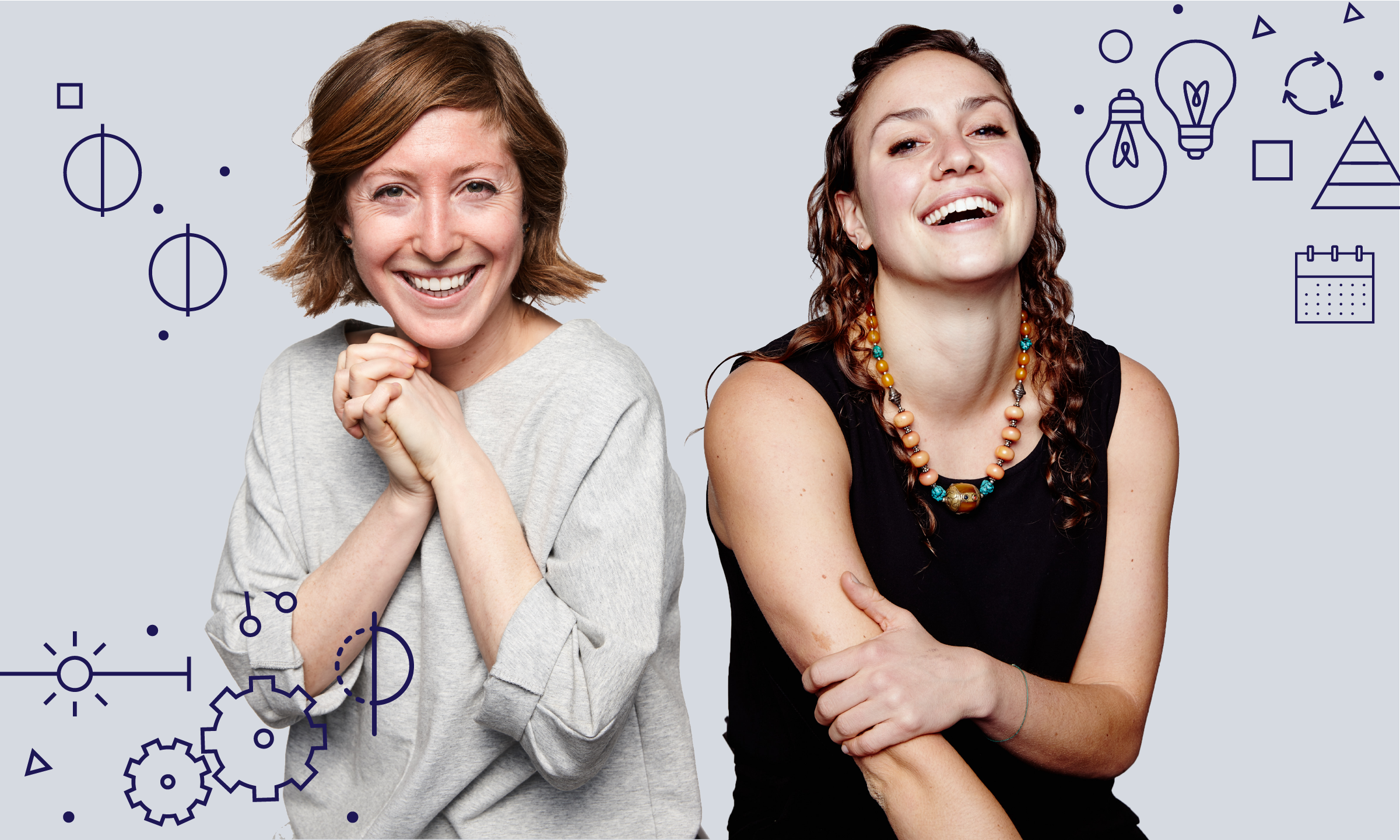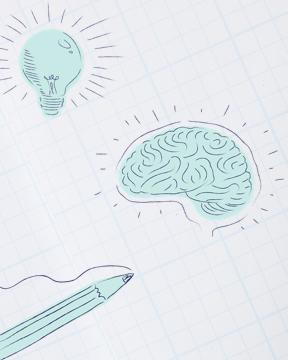
Before you read any further, hit play on the playlist below, bust a move (chair dancing is permitted), and take a few minutes to think about an intentionally designed experience that left you smiling from ear to ear. It could be a potluck, a conference, a retirement party, etc.
Experience design explained
Experience design is the intentional shaping of how people feel, think, and act during an interaction or event. It goes beyond planning activities; it’s about creating emotional resonance, prompting reflection, and designing moments that leave a lasting impact.
IDEO experience designers Jenny Gottstein and Olivia Vagelos have created transformational experiences for clients in a range of industries, including education, entertainment, mobility and healthcare. They’re part of the self-proclaimed merry group of mischief makers at IDEO’s Play Lab, where they tackle challenges across industries (from digital game concepts to destigmatizing mental health), using play to spark imagination, deepen engagement and bring joy to people of all ages.
Jenny and Olivia took over the Creative Confidence Podcast for a primer on experience design. We’ll get meta on that podcast episode in a little bit (it’s a great case study for designing an auditory experience). Listen to the episode for more juicy details and stories (a wedding reception, an entrepreneur’s pitch meeting, an incubator program for scientists) that show how just about any experience can be made better with a bit of intentional design.
Listen on Spotify or Apple Podcasts
4 ways to strengthen your experience design strategy
You’re guaranteed to have a great experience if Beyonce is there, but alas, her schedule is pretty booked up. Fortunately, with the right experience design strategy, you can create events that resonate, inspire, and stick with people long after they end– even without a celebrity guest appearance.
Whether you're planning a conference, workshop, or celebration, the key is to design for feelings not just logistics.
1. Include your audience in experience planning
It is exceptionally hard to inspire change in someone when you don't know anything about them. Transformation requires a shift in someone’s internal state, and you can’t tell your audience what to feel. Has a directive of “feel excited now” ever worked to amp up a crowd? You have to create the conditions that lead to that emotional shift. To do that, you have to know who they are and what they care about.
Too often we start by focusing on the activities we want to happen during our experience. Here’s the switch we’re inviting you to make: start with the feelings you want to inspire, and figure out the activities later.
Podcast example: An IDEO portfolio review where glow-in-the-dark paint and a blacklight were key ingredients.
2. Design a powerful opening moment
The beginning of the experience is your opportunity to set the tone and the rules of engagement. It shows the people you've invited what the experience is going to be all about and it helps people transition in from wherever it is they’re coming from—physically, spiritually, emotionally. In the world of play and game design we call this “entering the magic circle.”
Podcast example: A wedding where the happy couple created ways for their guests to meaningfully connect. A pitch meeting for an entrepreneur’s oral health business where emotions took center stage.
3. Design a memorable closing moment
You can't design for every second. And good news! You actually don't need to. People tend to remember the standout moments, both good and bad, and the ending of an experience (a concept called the “peak-end rule” that’s explored further in Chip and Dan Heath’s book The Power of Moments).
So don’t put all of your energy into the middle bits and completely ignore the ending. Be thoughtful about how you close out an experience. There’s no ice cream sandwich without the two cookies, amiright? Use the ending moment to offer closure by revisiting a prompt or idea from earlier, or generate some warm-fuzzies by sharing a moment of gratitude with your participants.
Podcast example: A seance for science where more than a few happy tears were shed by typically “all-business” types.
4. Prototype your experience
You might be familiar with the idea of prototyping for a product or service, but it does wonders for experiences too. We’re not saying you should plan everything (focus on the moments that matter, like openings and closings), but often we don’t plan the nitty gritty details of how an experience will unfold. Or on the flip side, we plan every last detail, but we don’t play it out. Prototyping your experience helps you build to think. By practicing it very badly a few times, you can cut the terrible ideas before they make it to the final experience.
Tools like Brain Dumps, Run of Shows, and Very Bad Run-Thrus (VBRTs) help you design for experience with intention and a little bit of humor. VBRTs (Very bad run thrus) eventually evolve to YOGRTs (Yes! Outstandingly great run thrus). A tip from the IDEO PlayLab: If you want to design an experience that is epic, you can’t take yourself too seriously.
Podcast example: Here’s where the time-space continuum starts to warp. The example in the podcast IS the podcast. Let’s dive into how Jenny and Olivia designed and prototyped it.
“It is exceptionally hard to inspire change in someone when you don't know anything about them.”
Olivia Vagelos
Case study: A live experience design webcast
To bring their own experience design strategy to life, Jenny and Olivia turned an IDEO U Creative Confidence Podcast episode into a live video event. It served as a test case for the very tips they were teaching.
Here’s how they applied each of the four principles to design an experience that was inclusive, interactive, and unforgettable.
1. Optimizing for a varied audience
Because the event would be repurposed as a podcast, they had to design for experience across different formats including video and audio. They made sure the content would resonate without visuals and offered takeaways that matched varying levels of familiarity with experience design.
Tip in action: They defined experience design clearly during the session and created a workbook as a free takeaway for deeper learning.
2. Opening with a dance party
Jenny and Olivia opened the digital event with a playful dance party, inviting attendees to share their name, location, and pronouns in the chat. This event experience design choice helped warm up the digital room and encouraged participation across time zones and cultures.
Live audience reaction:
“My 8 year old son here can’t believe the presenters are dancing this out ... lol ... that makes it totally worth it!” — Shonan
“Totally changed my mood, just awesome” — Chris
3. Closing with reflection and gratitude
They wrapped the session by asking participants to reflect on what they learned and share their biggest takeaways. Acknowledging the behind-the-scenes support team added authenticity and emotional closure; hallmarks of a well-executed experience design strategy.
Design insight: Closing moments stick. Ending with reflection and gratitude helps participants feel seen and valued.
4. Prototyping the format (VBRTs and all)
The final webcast was polished, but it didn’t start that way. Jenny and Olivia ran multiple Very Bad Run Thrus (VBRTs) to workshop timing, tone, and examples. Through iteration, they narrowed hours of content into a tight, 45-minute story arc—showcasing how prototyping is just as valuable in event design as it is in product design.
How might you design your experience to be impactful?
Alright, folks, let’s wrap this party up. In the words of a wise lead singer of a band you may have listened to in the ‘90s, “Every new beginning comes from some other beginning's end.” It’s time for you to take the wheel.
What’s one thing you might do to make your next experience more memorable and transformative?
Remember, the experience design workbook can help you put these tools into action.
Experience design resources for further exploration
Interested in learning more about experience design? Jenny and Olivia suggest digging into these resources for inspiration. Some are leading thinkers in experience design and strategy, some are from IDEO, and some are organizations or groups doing great work in this space.
-
The Power of Moments, by Chip and Dan Heath
-
The Art of Gathering, by Priya Parker
-
Emergent Strategy, by Adrienne Maree Brown
About Jenny Gottstein
As a Design Lead at IDEO, Jenny leads projects across industries, finding ways to leverage play and experience design to improve healthcare, transportation, education, new business ventures, circular economies and public policy.
About Olivia Vagelos
Olivia is an experiential, instructional, and community designer at IDEO. She works to build transformative spaces, relationships, and systems that empower people to be creative agents of change. She believes laughter and questions build the most beautiful things.
About IDEO’s Play Lab
IDEO’s Play Lab tackles challenges across industries, using play to spark imagination, deepen engagement and bring joy to people of all ages. Our deep knowledge about play psychology and game design is grounded in 25+ years in toy invention. Our projects range from designing everything from physical play spaces to digital game concepts, from mixed reality experiences to playful products, and we’re game to tackle the world’s meatiest challenges from destigmatizing mental health to moving our partners closer to operating within a circular economy. We help organizations connect with people at a deeper, emotional level that captivates, delights and inspires. Learn more at ideoplaylab.com.
- choosing a selection results in a full page refresh
- press the space key then arrow keys to make a selection



